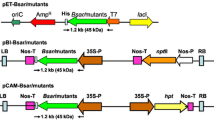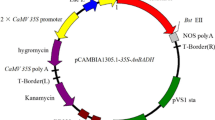Abstract
Key message
The glyphosate resistance in Escherichia coli and Arabidopsis was due to d -amino acid oxidase expression.
Abstract
Transgenic glyphosate-resistant crops have a high percentage in the total area devoted to transgenic crops worldwide. d-amino acid oxidase (DAAO) can metabolize glyphosate by oxidative cleavage of the carbon–nitrogen bond on the carboxyl side and yield aminomethyl phosphonic acid and glyoxylate, which are less toxic to plants than glyphosate. To date, reports on the use of DAAO to enhance glyphosate resistance in plants are lacking. In this paper, we report synthesis, and codon usage optimization for plant expression, of the DAAO gene by successive polymerase chain reaction from Bradyrhizobium japonicum. To confirm the glyphosate resistance of the DAAO gene, the recombinant plasmid pYPX251 (GenBank Accession No: AY178046) harboring the wild-type DAAO gene was transformed into DH5α. The positive transformants grew well both on solid and in liquid M9 medium containing 200 mM glyphosate. The optimized DAAO gene was transformed into Arabidopsis and 9 days after application of 10 mM glyphosate, the 4-week-old wild-type plants all died; by contrast, transgenic plants could grow normally. The proline content and peroxidase activity showed that glyphosate could induce proline accumulation and produce reactive oxygen species.






Similar content being viewed by others
Abbreviations
- AMPA:
-
Aminomethyl phosphonic acid
- DAAO:
-
d-amino acid oxidase
- EPSPS:
-
5-Enolpyruvylshikimate-3-phosphate synthase
- GAT:
-
Glyphosate acetyl-transferase
- GO:
-
Glycine oxidase
- GOX:
-
Glyphosate oxidoreductase
- PCR:
-
Polymerase chain reaction
- POD:
-
Peroxidase
- p251:
-
pYPX251
- ROS:
-
Reactive oxygen species
References
Barry GF, Kishore GM (1995) Glyphosate tolerant plants. US Patent 5,462,175
Bates LS, Waldren RP, Teare ID (1973) Rapid determination of free proline in water-stress studies. Plant Soil 39:205–207
Castle LA, Siehl DL, Gorton R, Lassner MW et al (2004) Discovery and directed evolution of a glyphosate tolerance gene. Science 304:1151–1154
Dill GM, Cajacob CA, Padgette SR (2008) Glyphosate-resistant crops: adoption, use and future considerations. Pest Manag Sci 64:326–331
Duan BQ, Wang XJ, Lu W, Lin M et al (2014) Development of highly glyphosate-tolerant tobacco by co-expression of glyphosate acetyltransferase gat and EPSPS G2-aroA genes. Crop J 2:164–169
Duke SO (2011) Glyphosate degradation in glyphosate-resistant and –susceptible crops and weeds. J Agric Food Chem 59:5835–5841
Duke SO (2014) Biotechnology: herbicide-resistant crops. In: Van Alfen N (ed) Encyclopedia of agriculture and food systems, vol 2. Elsevier, San Diego, pp 94–116
Duke SO, Powles SB (2008) Glyphosate: a once-in-a-century herbicide. Pest Manag Sci 64:319–325
Duke SO, Rimando AM, Pace PF, Reddy KN, Smeda RJ (2003) Isoflavone, glyphosate, and aminomethylphosphonic acid levels in seeds of glyphosate-treated, glyphosate-resistant soybean. J Agric Food Chem 51:340–344
Job V, Marcone GL, Pilone MS, Pollegioni L (2002) Glycine oxidase from Bacillus subtilis: characterization of a new flavoprotein. J Biol Chem 277:6985–6993
Klee HJ, Muskopf YM, Gasser CS (1987) Cloning of an Arabidopsis thaliana gene encoding 5-enolpyruvylshikimate-3-phosphate synthase: sequence analysis and manipulation to obtain glyphosate-tolerant plants. Mol Gen Genet 210:437–442
Lichtenthaler HK (1987) Chlorophylls and carotenoids: pigments of photosynthetic biomembranes. Methods Enzymol 148:350–382
Macadam JW, Nelson CJ, Sharp RE (1992) Peroxidase activity in the leaf elongation zone of tall fescue I. Spatial distribution of ionically bound peroxidase activity in genotypes differing in length of the elongation zone. Plant Physiol 99:872–878
Molla G et al (2003) Kinetic mechanisms of glycine oxidase from Bacillus subtilis. Eur J Biochem 270:1474–1482
Mortl M (2004) Structure–function correlation in glycine oxidase from Bacillus subtilis. J Biol Chem 279:29718–29727
Murray EE, Lotzer J, Eberle M (1989) Codon usage in plant genes. Nucleic Acids Res 17:477–498
Nicolia N, Ferradini G, Molla E, Veronesi D et al (2014) Expression of an evolved engineered variant of a bacterial glycine oxidase leads to glyphosate resistance in alfalfa. J Biotechnol 184:201–208
Pedotti M, Rosini E, Molla G, Savino C et al (2009) Glyphosate resistance by engineering the flavoenzyme glycine oxidase. J Biol Chem 284:36415–36423
Pollegioni L, Molla G (2011) New biotech applications from evolved d-amino acid oxidases. Trends Biotechnol 29:276–283
Pollegioni L, Piubelli L, Sacchi S, Pilone MS, Molla G (2007) Physiological functions of d-amino acid oxidase from yeast to humans. Cell Mol Llfe Sci 64:1373–1394
Pollegioni L, Schonbrunn E, Siehl D (2011) Molecular basis of glyphosate resistance-different approaches through protein engineering. FEBS J 278:2753–2766
Powles SB, Preston C (2006) Evolved glyphosate resistance in plants: biochemical and genetic basis of resistance. Weed Technol 20:282–289
Siehl DL, Castle LA, Gorton R, Keenan RJ (2007) The molecular basis of glyphosate resistance by an optimized microbial acetyltransferase. J Biol Chem 15:11446–11455
Sun YC, Chen YC, Tian ZX, Wang YP et al (2005) Novel AroA with high tolerance to glyphosate, encoded by a gene of Pseudomonas putida 4G-1 isolated from an extremely polluted environment in China. Appl Environ Microbiol 71:4771–4776
Tian YS, Xu J, Xiong AS, Yao QH et al (2011) Functional characterization of Class II 5-enopyruvylshikimate-3-phosphate synthase from Halothermothrix orenii H168 in Escherichia coli and transgenic Arabidopsis. Appl Microbiol Biotechnol 93:241–250
Trovato M, Mattioli R, Paolo C (2008) Multiple roles of proline in plant stress tolerance and development. Rendiconti Lincei 19:325–346
Waltz E (2010) Glyphosate resistance threatens Roundup hegemony. Nat Biotechnol 28:537–538
Xiong AS, Yao QH, Peng RH, Cheng ZM et al (2004) A simple, rapid, high fidelity and cost-effective PCR based two-step DNA synthesis (PTDS) method for long gene sequences. Nucleic Acids Res 32:e98
Xiong AS, Peng RH, Liu JG, Yao QH et al (2007) High efficiency and throughput system in directed evolution in vitro of reporter gene. Appl Microbiol Biotechnol 74:160–168
Xu J, Tian YS, Peng RH, Yao QH et al (2010) AtCPK6, a functionally redundant and positive regulator involved in salt/drought stress tolerance in Arabidopsis. Planta 231:1251–1260
Xue Y, Peng R, Xiong A, Li X, Zhang D, Yao Q (2009) Yeast heat-shock protein gene HSP26 enhances freezing tolerance in Arabidopsis. J Plant Physiol 166:844–850
Zhan T, Zhang K, Liu ZD et al (2013) Improving glyphosate oxidation activity of glycine oxidase from Bacillus cereus by derected evolution. PLoS One 8:e79175
Zhang X, Henriques R, Lin SS, Niu QW, Chua NH (2006) Agrobacterium-mediated transformation of Arabidopsis thaliana using the floral dip method. Nat Protoc 1:641–646
Zhou M, Xu H, Wei X, Zhu Z et al (2006) Identification of a glyphosate-resistant mutant of rice 5-enolpyruvylshikimate 3-phosphate synthase using a directed evolution strategy. Plant Physiol 140:184–195
Zhu B, Peng RH, Fu XY, Yao QH et al (2012) Enhanced transformation of TNT by Arabidopsis plants expressing an old yellow enzyme. PLoS One 7:e39861
Acknowledgments
The research was supported by the International Scientific and Technological Cooperation (13440701700), Agriculture Science Technology Achievement Transformation Fund (133919N1300), Young Foundation of Shanghai Academy of Agricultural Science (2010-14), National Natural Science Foundation (31200075, 31200076, 31200212). The funders had no role in study design, data collection and analysis, decision to publish, or preparation of the manuscript.
Author information
Authors and Affiliations
Corresponding author
Ethics declarations
Conflict of interest
We declare that we have no conflict of interest.
Additional information
Communicated by L. Peña.
Electronic supplementary material
Below is the link to the electronic supplementary material.
299_2015_1850_MOESM1_ESM.docx
Supplemental Table 1 Sequences for all primer sets used for chemical synthesis of DAAO gene according to plant codon usage bias. Letters in boxes are restriction endonuclease sites (DOCX 12 kb)
299_2015_1850_MOESM3_ESM.jpg
Fig. S2 RT-PCR analysis of the expression of DAAO (target gene) in other transgenic lines (Do1-15 except for Do3, Do6 and Do14) (JPEG 43 kb)
Rights and permissions
About this article
Cite this article
Han, H., Zhu, B., Fu, X. et al. Overexpression of d-amino acid oxidase from Bradyrhizobium japonicum, enhances resistance to glyphosate in Arabidopsis thaliana . Plant Cell Rep 34, 2043–2051 (2015). https://doi.org/10.1007/s00299-015-1850-5
Received:
Revised:
Accepted:
Published:
Issue Date:
DOI: https://doi.org/10.1007/s00299-015-1850-5




